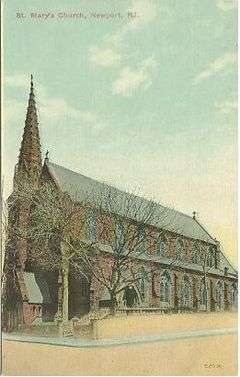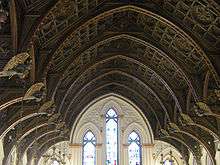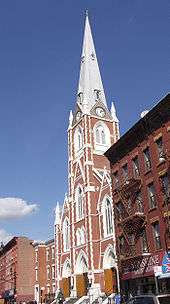Patrick Keely

Patrick Charles Keely (August 9, 1816 — August 11, 1896) was an Irish-American architect based in Brooklyn, New York, and Providence, Rhode Island. He was a prolific designer of nearly 600 churches and hundreds of other institutional buildings for the Roman Catholic Church or Roman Catholic patrons in the eastern United States and Canada, particularly in New York City, Boston and Chicago in the later half of the 19th century. He designed every 19th-century Catholic cathedral in New England.[1] Several other church and institutional architects began their careers in his firm.
Early life in Ireland
Keely was born in Thurles, County Tipperary, then a part of the United Kingdom of Great Britain and Ireland (alternatively another source states it was County Kilkenny),[1] on August 9, 1816, to a family in comfortable circumstances. His draftsman and builder father introduced him to architecture and training in construction, his father worked on the building of St. Patrick's College, Thurles and Patrick was educated there,[2] though nothing is recorded of his architectural design education.
Early life in Brooklyn, New York
Keely emigrated to the United States, landing at Castle Gardens in Manhattan in 1842, and settling in Brooklyn. He arrived at a time when Catholicism in the United States was expanding from its initial footholds in Baltimore, New York City and Boston. Initially, he worked as a carpenter and builder since there were few trained architects practicing and most structures were erected with the design assistance of the client and builder alone. Common practice held that the builder, whether trained as mason or carpenter, crafted his own plans, and details were often executed without even the aid of drawings. For a number of years Keely worked at his trade without attracting attention. During this time, he met the Rev. Sylvester Malone, a Roman Catholic priest his own age.
In 1846 Malone was sent to form a parish near the Brooklyn waterfront in the Williamsburg neighborhood. Together with Keely, he worked out a plan for a Gothic church possessing pointed arches, pinnacles, and a few buttresses. Working as a carpenter, Keely produced designs from which was built the Church of Sts. Peter and Paul in 1847.
Architectural career
The Church of Sts. Peter and Paul was considered an epoch in Catholic building in America. The much-praised work (demolished in 1957)[3] established him as a competent architect and builder at a time when a number of new Roman Catholic churches were being planned "but a relative scarcity of competent architects of the Roman Catholic faith, and Keely's reputation for honesty and integrity quickly made him a popular choice among the hierarchy and clergy throughout the eastern United States."[1]
Thereafter, Keely effectively became the in-house architect for the Roman Catholic archdioceses and was approached from all sides with requests for designs of churches and other necessary structures for an expanding religious life. In Brooklyn alone there was a great wave of Catholic settlers for whom churches were urgently needed and Keely was the only one thought of to do the work. He continued as a carpenter / craftsman in conjunction with his designing duties, handcrafting such ecclesiastical features of the reredos of the nearly demolished Saint Brigid's Church (1848) in the East Village of Manhattan.
Keely later partnered with his wife’s brother-in-law, James Murphy in Brooklyn, New York, and Providence, Rhode Island, under the name Keely & Murphy from the 1860s to 1867, until Murphy opened his own practice in Providence.[1] Keely worked throughout the eastern United States and Canada, primarily in the industrial mill towns and cities of the state of New York and New England, principally a designer of Roman Catholic churches or institutional buildings. Among his work were several cathedrals in the Northeast and "many of the more substantial parish churches" later "elevated to cathedral status during the twentieth century." He designed a few churches for Protestant congregations…."[1]
Several later noteworthy architects began their careers with Keely's firm, including Elliott Lynch, James Farmer (his wife’s brother), James Murphy (his wife’s brother-in-law), his sons, Charles Keely (died 1889, Hartford, Connecticut), John J. Keely (died 1879, Brooklyn), and son-in-law, Thomas F. Houghton.[1]
Keely died in 1896 after a long illness, while still directing the completion of several churches with his son-in-law, Thomas Houghton. He was buried in Holy Cross Cemetery, Brooklyn, under an inauspicious polished granite block embossed "KEELY."[4]
Works
- Arkansas
- Cathedral of St. Andrew, Little Rock
- Connecticut
- Cathedral of St. Joseph, Hartford (1889, burned 1956)
- Church of St. Mary, the Immaculate Conception, Derby
- Sacred Heart Church, Waterbury
- Cathedral of St. Augustine, Bridgeport
- Assumption Church, Ansonia
- St. Mary of the Immaculate Conception Church, Baltic
- St. Peter Church, Danbury (Kiely and Murphy)
- District of Columbia
- St. Dominic Church, Washington
- Illinois
- Cathedral of the Holy Name, Chicago
- St. James Church, Chicago (demolished, 2014)
- Nativity of Our Lord Catholic Church, Chicago
- St. Stanislaus Kostka Church, Chicago
- St. Mary Carmelite Church, Joliet
- Louisiana
- St. Joseph Church, New Orleans (1869-1875)
- Indiana
(initial plans, the present edifice was built following other plans)
- Maine
- Cathedral of the Immaculate Conception (1869), Portland
- St. Joseph's Church (1865), Lewiston
- St. John's Church (1855), Bangor
- Maryland
- Corpus Christi Church, Baltimore
- Massachusetts
- 1858-1861: Immaculate Conception Church, Boston (Jesuit Urban Center)[5]
- Immaculate Conception Church, Newburyport
- 1867-1875: Cathedral of the Holy Cross (1866–1875), Boston[6]
- Holy Trinity Church, Boston
- Our Lady of Victories Church, Boston
- St. James Church, Boston
- St. Mary's Church, Boston (demolished 1977)
- St. Francis De Sales Church, Roxbury (original building, demolished)
- 1859: St. Francis de Sales Church, Charlestown[7]
- St. Augustine Church, South Boston
- St. Vincent de Paul Church, South Boston
- Sts. Peter and Paul Church, South Boston (rebuild of original church by J. Fox Bryant)

- St. Peter Church Dorchester
- St. Margaret Church, Dorchester (with Thomas Houghton)
- St. Thomas Aquinas Church, Jamaica Plain
- St. Mary Church, Charlestown
- Church of the Holy Redeemer, East Boston
- Church of the Assumption, East Boston
- St. John Church, Cambridge (with James Murphy)
- Sacred Heart Church, Cambridge (with Patrick W. Ford)
- Sacred Heart Church, Weymouth (burned 2005)
- Sacred Hearts Church, Malden
- Sacred Heart Church, Lynn
- St. Mary Church, Lawrence
- St. Patrick's Church (1853), Lowell
- St. Michael Church, Lowell
- Church of the Immaculate Conception, Lowell
- St. Peter Church, Lowell (demolished)
- St. Paul Church, Hingham
- Cathedral of St. Mary of the Assumption, Fall River
- St. Joseph's Church, Fall River
- St. Patrick's Church, Fall River
- St. Lawrence, Martyr Church, New Bedford
- Cathedral of St. Michael, Springfield
- Holy Name of Jesus Church, Chicopee
- St. Joseph Church, Pittsfield
- St. Jerome Church, Holyoke
- New Hampshire
- Cathedral of St. Joseph, Manchester (with Patrick W. Ford)
- New Jersey
- St. Bridget Church, Jersey City
- St. Patrick Church, Jersey City
- St. Peter Church and College Jersey City
- St. Michael Church, Jersey City
- Church of the Sacred Heart, New Brunswick
- St. Peter the Apostle Church, New Brunswick
- Cathedral of St. John the Baptist, Paterson (1865)
- Church of the Sacred Heart Mt. Holly
- St Patrick's Pro-Cathedral Newark
- St. Mary Church, South Amboy
- New York
- Church of Sts. Peter and Paul, Brooklyn (1847-1957)
- Saint Brigid's Church, Manhattan (1848)
- St. Ann's Church, Brooklyn (1860), northwest corner of Gold and Front Streets[8]
- St. Francis Xavier Church (Manhattan), 16th Street, Manhattan[9][10][11][12][13][14]

- St. Anthony of Padua's Church (Brooklyn, New York)
- Church of St. Stephen and the Sacred Heart (Brooklyn, New York)
- St. Bernard's Church (1873–1875) (now the home of Our Lady of Guadalupe Parish)
- St. Boniface Church, Brooklyn (now the Brooklyn Oratory)
- St. Charles Borromeo Church (1868), 21 Sidney Place, Brooklyn, "reputedly his 325th church design."[8]
- Church of the Holy Innocents, Manhattan (completed 1870)
- Cathedral of the Immaculate Conception, Albany (1848-1852)
- St. Joseph's Cathedral, Buffalo
- St. Joseph's Church, Albany (1855-1860, closed)
- St. Mary Church, Yonkers (an early church by Keely, replaced in 1880)
- St. Patrick's Church (Brooklyn, New York)
- St. Vincent de Paul Church, Brooklyn
- Ohio
- Cathedral of St. John the Evangelist, Cleveland
- St. John the Baptist Church, Canton
- Church of St. Francis de Sales, Toledo (Parish closed, 2005, still open for daily noon Mass)
- Pennsylvania
- St. Peter Cathedral (1873–1875), Erie
- St. Joseph Church, Erie
- Church of the Assumption, (Philadelphia, Pennsylvania)[15]
Saint John the Baptist, Philadelphia, PA
- Rhode Island
- Cathedral of Saints Peter and Paul (1878), Providence
- St. Joseph's Roman Catholic Church (Providence, Rhode Island) (NRHP)
- St. Mary Church, Newport
- South Carolina
- St. Patrick Church, Charleston[16]
- Cathedral of Saint John and Saint Finbar, Charleston (1850–1854, burned December 1861), rebuilt as the Cathedral of Saint John the Baptist (1907, completed March 2010)
| Wikimedia Commons has media related to Patrick Charles Keely. |
- Vermont
- Cathedral of the Immaculate Conception, Burlington (burned 1973)
- St. Peter Church, Rutland, Vermont
- St. Bridget Church, West Rutland, Vermont[17]
- West Virginia
- Wisconsin
- St. Bernard's Church, Watertown
- Canada
- Church of Le Gesù (1865), Montreal, Quebec
- St. Mary's Basilica (1820–1899), Halifax, Nova Scotia
Notes
- 1 2 3 4 5 6 Decker, Kevin F. " Patrick Charles Keely (1816-1896)", University of Plattsburgh, New York (2000)
- ↑ Patrick Charles Keely Dictionary of Irish Architects.
- ↑ Keely Society
- ↑ Find a Grave
- ↑ Susan and Michael Southworth, AIA Guide to Boston, Third Edition, (Guildford, Connecticut: GPP, 2008), p.146.
- ↑ Susan and Michael Southworth, AIA Guide to Boston, Third Edition, (Guildford, Connecticut: GPP, 2008), p.155.
- ↑ Susan and Michael Southworth, AIA Guide to Boston, Third Edition, (Guildford, Connecticut: GPP, 2008), p.241.
- 1 2 Robert A. M. Stern, Thomas Mellins, and David Fishman. New York 1880: Architecture and Urbanism in the Gilded Age. (New York: The Monacelli Press, 1999), p.875
- ↑ Gray, Christopher. "Streetscapes: West 16th Street; A Side-Street Surprise: A Monumental Church" New York Times (March 27, 2005)
- ↑ White, Norval & Willensky, Elliot (2000), AIA Guide to New York City (4th ed.), New York: Three Rivers Press, ISBN 978-0-8129-3107-5, p.192
- ↑ St. Francis Xavier Church at www.nyc-architecture.com
- ↑ Saint Francis Xavier: Restoration history
- ↑ Alejandro Bahamón and Àgata Losantos, New York: A Historical Atlas of Architecture (New York: Black Dog and Leventhal Publishers, Inc., 2007), p.99.
- ↑ David W. Dunlap, From Abyssinian to Zion: A Guide to Manhattan's Houses of Worship. (New York: Columbia University Press, 2004.) p. 204.
- ↑ http://www.evri.com/media/article;jsessionid=x1txbt36q0v8?title=Historic+Philadelphia+church+to+be+torn+down&page=http://www.philly.com/philly/news/20100911_Historic_Philadelphia_church_to_be_torn_down.html&referring_uri=/person/patrick-keely-0xea408%3Bjsessionid%3Dx1txbt36q0v8&referring_title=Evri
- ↑ "The New St. Patrick's". Charleston News & Courier. January 28, 1886. p. 8. Retrieved Nov 11, 2012.
- ↑ http://www.saintbridgetchurch.com/history.htm St. Bridget Church, West Rutland VT
References
- Francis William Wynn Kervick. "Patrick Charles Keely, Architect: A Record of His Life and Work." South Bend, Indiana: S.V., 1953.
.jpg)